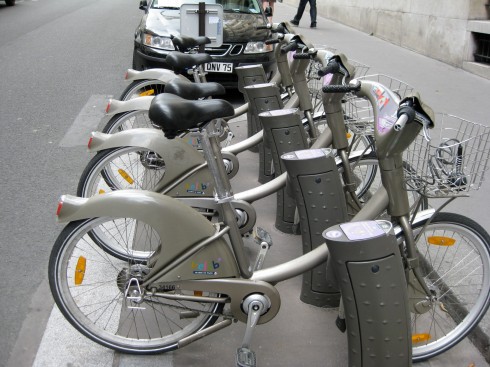This guest posting is by permission of the author, Alan Forkosh, who writes:
Here are some observations on how the Vélib community bike system in Paris works.
My thoughts on the issue crystallized after a trip to Paris in the fall of 2009 and stemmed from 3 observations:
- The heavy use of Vélib and the high density of Vélib stands;
- The lack of Vélibs parked in the wild;
- The fact that the common way of obtaining a Vélib was to swipe an authorized Navigo transit pass at the stand holding the bike.
By the way, I have some pictures of Vélibs and other bikes online.
A community bike sharing program is not about the bike: it’s about overcoming the shortcomings of the mass transportation system and making it better serve the users without increasing congestion. The problem with mass transit is that unless you are very lucky, it doesn’t quite serve your needs. The inefficiencies in waiting for trains or buses, waiting for transfers, and not going exactly where you want to go add up. In many cases, you get very frustrated just attempting the trip. A community bike system alleviates that by giving you an almost instant way to cut the delays and straighten routes to go from place to place without the intra-system delays. You go to a bike station near your origin, swipe your pass, and take the associated bike. When you reach your destination, you click the bike into a stand and are done with it. The grid is dense, so that these stations should be no more than 1000 feet from the origin and destination (I think that Vélib stations are spaced no more than 300 meters [about 1000 feet] apart).
In Paris, it is rare to see an unattended Vélib away from a bike station; the stations provide more convenient and secure parking than trying to manipulate the lock provided on the bike. Also, if you leave the bike unattended away from a station, you are responsible for it; once you secure it to its post at a station, you’re done with it. Note that Paris is only about 6 miles across and there is no extra charge for a Vélib for the first 30 minutes. So you should be able to complete almost any trip without charge. I’d be surprised if there is any measurable keeping of a Vélib over 30 minutes.
So, the intention of the program is mobility: the bike is only an instrument to promote that. The bike should be used when it makes sense to travel that way. You don’t need to plan. This idea would fail if the user were required to provide any bulky personal equipment (helmet, gloves, etc.) to use the bike.

